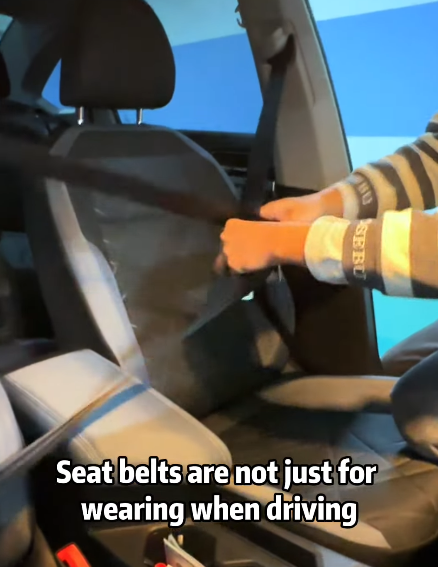
When you think of car seat belts, the first thing that comes to mind is safety — and rightly so. Since their widespread adoption in the mid-20th century, seat belts have saved countless lives and prevented serious injuries during road accidents. Most people use them without giving a second thought, simply clicking them into place before driving off. But did you know that your car’s seat belt does more than just hold you in place during a crash?
Modern seat belts are sophisticated safety devices engineered with multiple hidden functions that enhance protection, comfort, and convenience. In this article, we’ll uncover some of the lesser-known but incredibly important roles your seat belt plays in ensuring your safety.
1. Pretensioners: Fast Action in a Flash
One of the most important hidden functions of modern seat belts is the pretensioner mechanism. In the event of a collision, this device automatically tightens the belt to remove slack, securing the occupant firmly in the seat before the impact forces peak.
Pretensioners work in conjunction with the vehicle’s airbag system. As sensors detect a crash, the pretensioner activates within milliseconds — often before you even realize what’s happening. This function ensures that you’re not thrown forward violently, which can significantly reduce the risk of injury.

2. Load Limiters: Gentle Control of Force
After the pretensioner tightens the belt, another hidden feature kicks in: the load limiter. This component allows a small amount of give in the seat belt after it’s fully engaged. Why is this important?
While you want the belt to keep you secure, too much force against your chest can cause serious injuries like rib fractures. Load limiters reduce this risk by controlling the force exerted by the belt, gently releasing some tension during a crash. It’s a fine balance between keeping you restrained and preventing the belt itself from becoming a hazard.
3. Adjustable Upper Anchors: A Custom Fit
Ever noticed that you can raise or lower the point where your seat belt meets your shoulder? This is due to adjustable upper anchors, a small but important feature that many drivers overlook.
Having the shoulder belt positioned correctly — not too high or too low — ensures maximum safety and comfort. If the belt cuts across your neck or slides off your shoulder, it can be ineffective or even dangerous in a crash. Always adjust the anchor point to align the belt snugly across your chest and shoulder.
4. Seat Belt Reminder Systems: More Than Just a Beep
The warning beep or flashing dashboard light when you forget to buckle up isn’t just there to annoy you. Modern cars use advanced seat belt reminder systems that monitor occupancy and belt usage in real-time.
These systems often use pressure sensors in the seats and buckle sensors to detect if a passenger is seated but unbuckled. Some even escalate their warnings — from gentle reminders to loud chimes and persistent alerts — until the seat belt is properly fastened. These systems play a key role in encouraging consistent seat belt use, which dramatically increases survival rates in crashes.

5. Integrated Child Safety Features
Many cars today come equipped with built-in seat belt systems for child safety, especially in the back seats. These include locking retractors that allow for secure installation of child car seats without needing additional accessories.
When installing a child safety seat, you can engage the seat belt in a special mode that keeps it tightly locked, providing a stable and secure hold. This is critical because a loose car seat can become a projectile in an accident, putting both the child and other passengers at risk.
6. Rear Seat Belt Airbags
Some high-end vehicles now include seat belt airbags in the rear seats. These belts feature small, built-in airbags that inflate in a crash to spread impact forces over a wider area of the occupant’s torso.
Especially beneficial for children and older adults with more fragile bones, these inflatable belts reduce pressure on the chest and ribs. They’re designed to work seamlessly with traditional airbags, offering an extra layer of protection.
7. Force Limiters in Seat Belt Retractors
Most people don’t realize that the retractor — the part that pulls the seat belt back when you release it — is more than just a coil. Some seat belt retractors are equipped with force limiters that sense rapid movements or deceleration, locking the belt in place to keep you from moving forward suddenly.
This feature engages even before a crash occurs, such as during hard braking or sharp turns, helping to prevent injuries from sudden motion or secondary collisions.

8. Emergency Locking Retractor (ELR) vs. Automatic Locking Retractor (ALR)
There are two main types of retractors used in seat belts: Emergency Locking Retractors (ELR) and Automatic Locking Retractors (ALR). ELRs lock the belt only during sudden deceleration or impact, while ALRs lock as soon as you pull the belt all the way out — a function often used when securing a child safety seat.
Understanding the difference helps ensure proper usage. For example, if you’re installing a child seat, you should use the ALR mode to keep the seat firmly in place.
9. Anti-Submarining Features
During a frontal crash, there’s a risk that passengers could slide under the seat belt — a phenomenon called submarining. To combat this, modern seat systems include anti-submarining features like seat cushions designed to prevent downward movement and keep the pelvis properly restrained.
Some seat belts are angled or routed specifically to help reduce the chance of this dangerous motion. This hidden safety element plays a critical role in preventing abdominal injuries.
10. Seat Belt Webbing Technology
Even the material used in seat belts has evolved significantly. Today’s belts are made from high-strength synthetic fibers like polyester, designed to withstand extreme forces and temperatures.
Some belts include woven indicators that show when the belt has been stretched due to a collision — a sign that it needs replacement. Others include water-resistant or anti-friction coatings for better durability and user comfort.

Conclusion: More Than Just a Strap
The seat belt might seem like a simple piece of fabric, but it’s a highly engineered safety device loaded with smart, hidden functions. From pretensioners and load limiters to airbag integration and child safety features, today’s seat belts are more capable than ever of protecting drivers and passengers alike.
The next time you buckle up, remember that you’re engaging a system that’s been carefully designed to respond in milliseconds to life-threatening situations. And while airbags and other high-tech features often steal the spotlight, it’s the humble seat belt — with all its hidden capabilities — that remains your car’s most essential safety component.
So yes, now you know: your car seat belt is doing a lot more than just holding you in place.



